The People and Nature Survey for England: Monthly interim indicators for May 2020 (Experimental Statistics)
Published 7 July 2020
Applies to England
1. Other pages in this release
The People and Nature Survey for England is one of the main sources of data and statistics on how people experience and think about the environment. It began collecting data via an online panel (adults aged 16 and older) in April 2020, and runs continuously, in line with Government Statistical Service guidance on data collection during the COVID-19 crisis. The People and Nature Survey will tell us about how COVID-19 is impacting people’s experience of green and natural spaces, how this is associated with physical and mental health, as well as how people’s attitudes to nature and behaviours are changing at this time. Data and insights from the People and Nature Survey will provide important evidence on impacts to support response and recovery, both under current restrictions and as requirements to stay at home ease.
Further information about the People and Nature Survey for England can be accessed alongside the first set of monthly interim indicators (April 2020).
To receive updates on the survey, including data releases and publications, sign-up via the People and Nature User Hub.
The People and Nature Survey defines public green and natural spaces as including:
- green spaces in towns and cities (e.g. parks, canals);
- the countryside (e.g. farmland, woodland, hills and rivers);
- the coast (e.g. beaches, cliffs) and activities in the open sea;
- visits of any duration (including short trips to the park, dog walking etc.)
- they do not include: private gardens; outside places visited as part of someone’s employment; spaces outside the UK.
Additional questions are asked about private gardens.
Subsequent reporting of monthly interim indicators and quarterly results from the People and Nature Survey respondent dataset will be able to determine changes and trends in the types of green and natural space used and equality of access to those spaces as the COVID-19 restrictions change over time.
The People and Nature Survey builds on and replaces the Monitor of Engagement with the Natural Environment (MENE) survey that ran from 2009 to 2019 and was designated as a National Statistic. While the People and Nature Survey has similar objectives to MENE, the move to an online panel method for data collection is a noteworthy change in methodology (MENE used face-to-face methods).
It is important to note that MENE survey results are not directly comparable to the People and Nature Survey results, owing to these differences in survey methods, and therefore it is unclear whether differences observed are due to changes in the population or changes in survey methods. Any use of MENE data for context should be with caution and understanding of the limitations (see Strengths and Limitations).
2. Main findings
- During the period 1st–31st May, 60% of adults in England said that they had spent time outside in green and natural spaces in the previous two weeks. This is an increase in comparison to April (up from 49%).
- A further 32% of adults reported that they had not spent any time in these places in the previous two weeks. This is a decrease in comparison to April (down from 46%).
- Just over a fifth of adults (22%) reported that they had not visited any green and natural space in the previous month (down from 26% in April).
- Since the coronavirus restrictions began, 36% of adults reported spending more time outside.
- The main reasons reported for not spending free time outdoors were staying at home to stop coronavirus spreading and/or related to Government restrictions (63%) and poor physical health/illness (11%).
- Of the adults who are not getting outside: half (50%) were worried about contracting or spreading coronavirus while visiting green and natural spaces; 39% were prevented from getting outside because of concerns about over-crowding and not being able to keep a safe distance from others; and, almost a fifth (18%) reported concerns about lack of facilities such as public toilets, baby changing areas or benches.
- The large majority of adults agreed that green and natural spaces should be good places for mental health and wellbeing (89%) and places that encourage physical health and exercise (83%).
- The large majority of adults (85%) agreed that ‘being in nature makes me very happy’ with 74% taking more time to notice and engage with everyday nature, such as listening to birdsong or noticing butterflies.
- Forty one per cent of adults have reported that ‘nature and wildlife is more important than ever to my wellbeing’; 41% reported visiting local green and natural spaces has been even more important to their wellbeing.
- Adults partaking in wildlife watching while in green and natural spaces increased in May (23%) compared to April (16%).
- Since coronavirus restrictions began almost three quarters of adults (72%) reported reducing the amount that they drive or travel by car, 40% reported reducing the amount of food their household throws away.
Data for this survey were collected between 1st and 31st May 2020. Results from this survey therefore cover a period where restrictions on movement were still in force, which required everyone to stay at home apart from for a limited number of reasons, and the date when restrictions on movement were eased (10th May). This page summarises the latest advice on accessing greenspace safely.
3. Experimental statistics
All initial releases from the People and Nature survey will be released as Experimental Statistics. This status highlights to users that the statistics are in the testing phase and that Natural England is still working on further developing the methodologies used in their production.
Natural England have worked to ensure adherence to the Code of Practice throughout all stages of the People and Nature Survey, including in the production of these interim indicators. Further detail on methods used and data quality is available in the ‘Methodological note’ and ‘Strengths and Limitations’ sections of this release, respectively. In June 2020, the Office for Statistical Regulation published a ‘rapid review’ of these statistics, which Natural England are using to improve the quality of releases.
The experimental statistics in this publication are based on a survey of 2,083 adult respondents conducted online continuously between 1st–31st May 2020 (inclusive). Throughout this bulletin, “this month” and “May” refers to this period. Figures can also be found in the supporting datasheet.
These interim indicators have been generated quickly, using interim and experimental methods for the purpose of understanding the potential impacts of COVID-19 on how people are engaging with the natural environment in England. Interim weights have been generated for these indicators using weighting solutions developed for the Monitor of Engagement with the Natural Environment (MENE). There will likely be small differences between these monthly interim indicators and full People and Nature Survey results due to the differences in weighting approaches (see ‘Methodological note’). Natural England will be releasing a weighted respondent dataset for the People and Nature Survey, as experimental statistics, on a quarterly basis, starting in September 2020.
Although other data sources are referred to in order to provide context in this release, direct comparisons between the People and Nature Survey and MENE should not be made (see ‘Introduction’ and ‘Strengths and Limitations’)
We seek feedback from stakeholders on the interpretation and presentation of the indicators and will make adjustments as appropriate and where possible. These experimental statistics will continue to be developed over the first year of the People and Nature Survey, with a view to ultimately securing National Statistic designation. We welcome all feedback from users to aid this development by email to: people_and_nature@naturalengland.org.uk
4. Time spent in green and natural places
Survey respondents were asked how many times, if at all, they visited green and natural spaces in the last 14 days.
In May, 60% of respondents reported taking a visit to a green and natural space in the last 14 days. This is an increase compared to April (up from 49%). Thirty two percent reported that they had not visited such a space over the previous 14 days (down from 46% in April) with 22% making no visits within the last month (down from 26% in April).
In May, 52% of adults in England visited green and natural spaces in the previous 7 days, compared to 41% in April. This is broadly consistent with historical MENE data for May 2018, where more than half of adults (59%) spent time in green and natural spaces in a seven day period.
The Office for National Statistics ‘Coronavirus and the social impacts on Great Britain survey’ collects data on the proportion of adults in Great Britain reporting visiting a park or greenspace in the past 7 days, which also shows that visit-taking increased over the month of May (Figure 1). However, proportions of people visiting were lower for those with any specific health conditions and those aged over 70.
Figure 1: Proportion of adults in Great Britain making a visit to a park or greenspace in the last 7 days across the period 3rd April to 24th May. Visit-taking increased for all people across the UK population but proportions of people visiting were lower for those with any specific health conditions and those aged over 70.
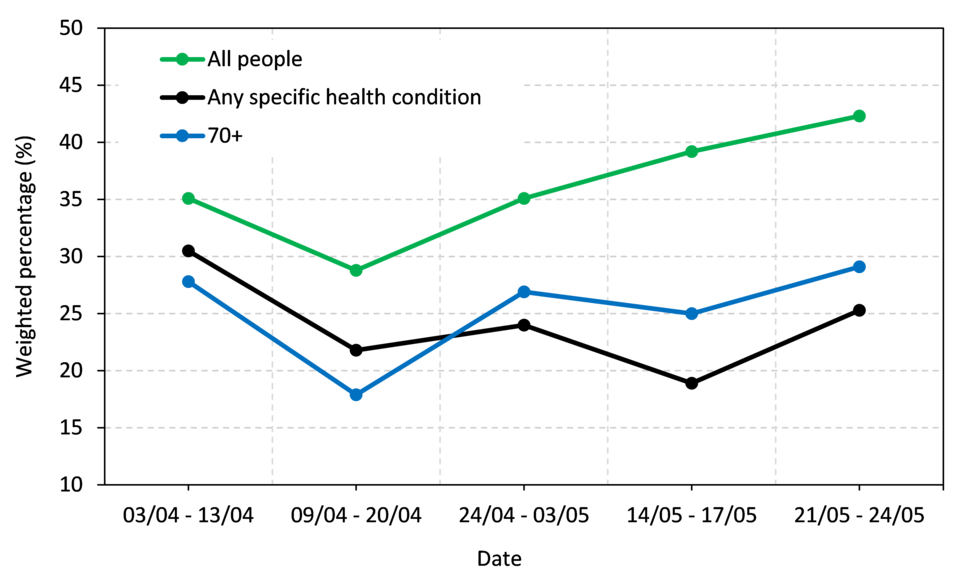
Figure notes
Source: Office for National Statistics (ONS) - Coronavirus and the social impacts on Great Britain
(1) Any specific health condition is defined as a chronic or long-term illness that can cause the individual to be more at risk of initial infection and in fighting the infection.
5. Types of green and natural spaces visited
Survey respondents were asked about the types of green and natural spaces they had visited during the last month (Figure 2). Urban green space (such as a park, field or playground) was the most visited type of space (44% of respondents reported making a visit in the last month), followed by visits to fields, farmland and countryside (29%). Visits to woodland or forests (27%) and to rivers, lakes or canals (24%) were the third and fourth most popular types of visit. These figures are comparable with the survey’s April figures.
Twenty two percent of respondents reported taking no visits to any green and natural space in the last month (down from 26% in April).
Figure 2: Proportion of adults in England visiting different types of green and natural spaces within the last month (May 2020). Corresponds to question 2 in the People and Nature Survey. Urban green space was the most visited type of space, followed by visits to fields / farmland / countryside. Just over one fifth of respondents reported no visits at all.
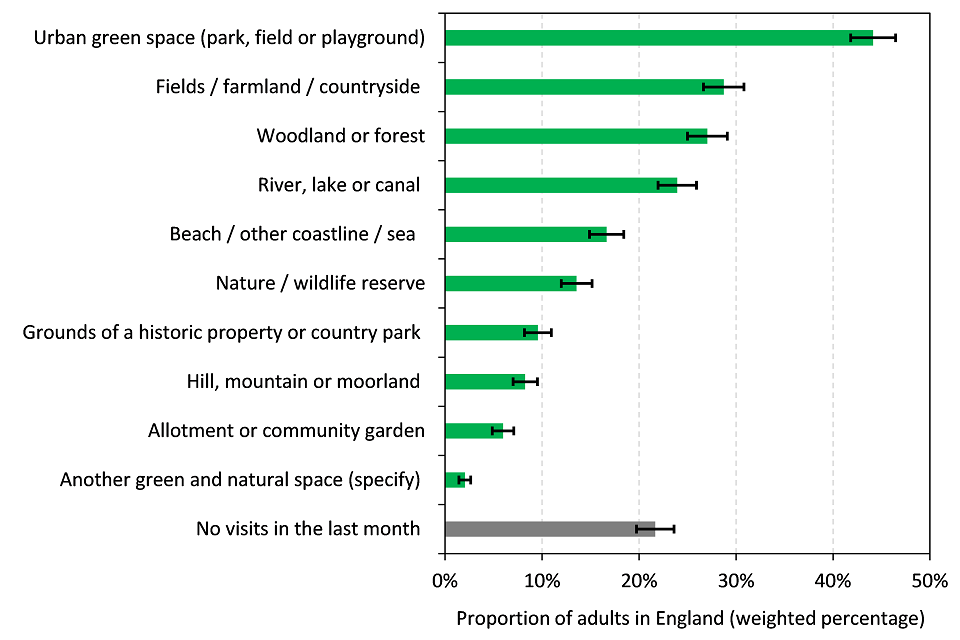
Figure notes
Source: Question 2 in the People and Nature Survey: Which of the following type(s) of green and natural spaces have you visited during the last month?
(1) May refers to the period May 1st to 31st (inclusive).
(2) The sample for this question was 2,015 respondents.
(3) Error bars represent the 95% confidence interval of the mean (see Glossary).
Previous research from the MENE survey also found that urban green spaces are usually the most visited of any green and natural space in 2018/19.
Analysis of Google COVID-19 Community Mobility data[footnote 1] for this report (Figure 3) found that, on average, park usage in England was generally higher during May than during Google’s pre-COVID-19 winter baseline period (3 January to 6 February 2020). In addition, there was an overall upward trend in visits as May progressed[footnote 2]. This is in contrast to the April figures where park usage was generally lower than the baseline.
Figure 3: Google COVID-19 Community Mobility trends for parks (including national parks, public beaches, marinas, dog parks, plazas and public gardens) in England during spring/early summer 2020 based on daily averages (medians) in relation to the equivalent day-of-the-week Google baseline averages (3 January to 6 February 2020). The baseline is marked as zero on the graph, bars below the zero-line show reductions in park use compared to the baseline and bars above the zero-line show increases compared to the baseline. Visits in May were generally higher than the baseline, showing an upward trend over the month.
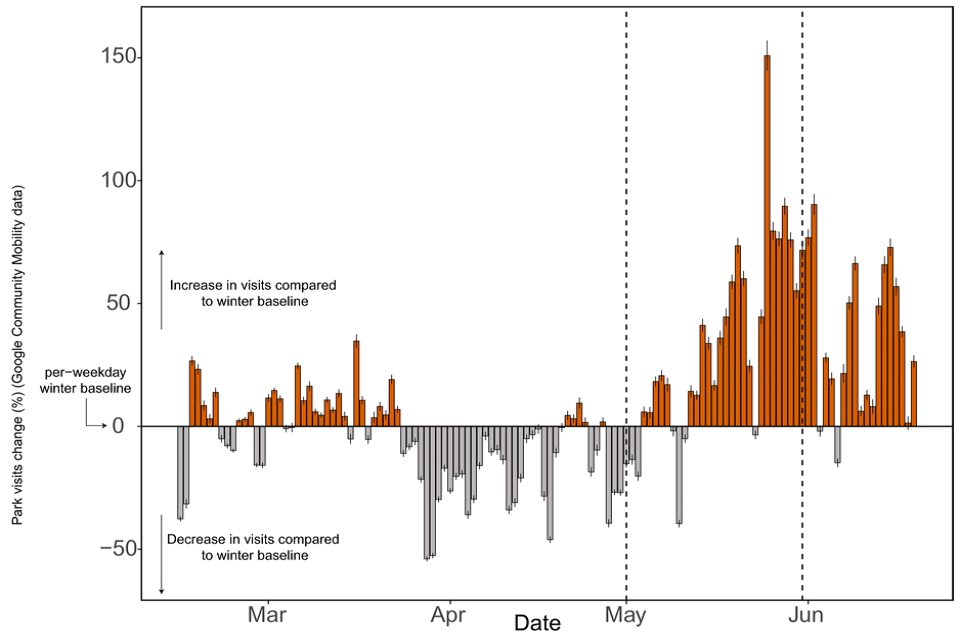
Figure notes
Source: Figure generated using Google COVID-19 Community Mobility data. Analysis by Scarlett Kynoch, University of Exeter and Dr. Matt Lloyd Jones, European Centre for Environment & Human Health, University of Exeter Medical School.
6. Activities undertaken in green and natural spaces
Survey respondents were asked which activities, if any, they undertook during a specific visit to a green and natural space in the last 14 days (Figure 4).
Figure 4: Proportion of adults in England who spent time outside in the last 14 days by activities undertaken (May 2020). Walking (including taking the dog for a walk) was the most frequently stated activity, undertaken on 3 out of 4 visits. Wildlife watching was the second most frequently stated activity undertaken on almost 1 in 4 visits.
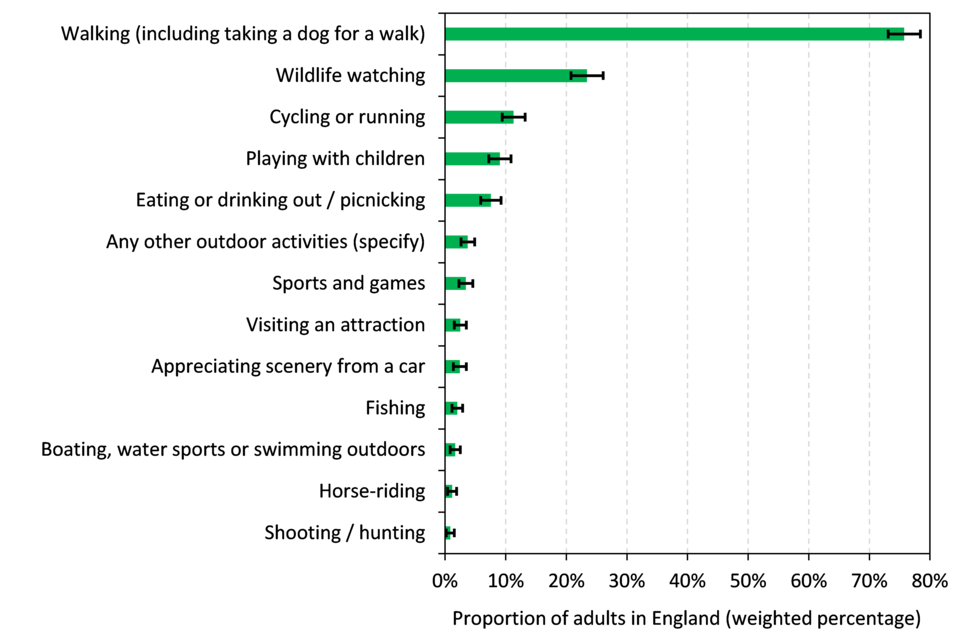
Figure notes
Source: Question 18 in the People and Nature Survey: Which of these activities, if any, did you do on this specific visit?
(1) May refers to the period May 1st to 31st (inclusive).
(2) The sample for this question was 1,144 respondents who took a visit in the last 14 days.
(3) Error bars represent the 95% confidence interval of the mean (see Glossary).
(4) Respondents can select more than one option and so percentages will not add up to 100%.
In May, the most popular activity was walking (including taking a dog for a walk) (76%), which is similar to reported levels of walking activity for April (79%).
Almost a quarter of adults reported wildlife watching (23%) in May, which is an increase compared to April, when only 16% of adults said that they undertook this activity.
Although the data are not directly comparable, the percentage of people walking is consistent with the historical MENE trend for the month of May (2009-2019), which found that 76% reported walking as an activity (45% with a dog and 31% without a dog). Whereas a much smaller proportion of adults (4%) reported wildlife watching. This suggests that there has been an increase in the number of people wildlife watching linked to COVID-19 restrictions. Subsequent reporting of results from the People and Nature Survey will be able to determine if this level of engagement continues.
This hypothesis is supported by a recent RSPB survey[footnote 3] of adults in England during 14-15 May 2020, which found that 71% of respondents had sought out places where they could enjoy nature while taking their permitted daily exercise.
7. Frequency of time spent outside - adults
Respondents were asked: In the last 12 months, how often, on average have you spent free time outside in green and natural spaces?
In May, 74% percent of adults reported that they normally spent time in green and natural spaces at least once a week. These findings are consistent with results for April, when 73% adults said they spent time in green and natural spaces at least once a week.
Note that a smaller proportion of adults spent time outside in May this year (52% at least once in the last week) than their reported average over 12 months (74% at least once a week), which suggests that COVID-19 restrictions are having an impact on these behaviours.
8. Reasons for not spending time outdoors
Respondents who had not visited a green and natural space within the last 14 days were asked three questions related to their reasons for not doing so:
- What was the main reason or reasons for not spending free time outdoors in the last 14 days? (Figure 5)
- Thinking about visiting green and natural spaces, are you concerned or worried by any of the following? (Figure 6)
- Thinking about the time since coronavirus restrictions were introduced, have any of the following reasons prevented you spending time outside? (Figure 7)
The majority of adults who did not spend time outdoors in the last 14 days reported that their main reason was related to Government restrictions and/or staying at home to stop coronavirus spreading (63%). This figure is lower than the equivalent percentage from April (70%). Half of respondents (50%) were worried or concerned about contracting or spreading coronavirus if they visited green or natural spaces, compared with 57% in April. Thirty nine percent were concerned about over-crowding and not being able to keep their distance from other people and 37% were concerned about breaking coronavirus restrictions.
Of those not getting out: 27% of adults reported that they had not left their home at all since coronavirus restrictions were introduced.
Eleven percent of respondents cited poor physical health as a main reason for not visiting green and natural spaces in the last 14 days (up from 7% in April), with 7% citing poor mental health or well-being (up from 4% in April).
Figure 5: The main reason(s) for not spending free time outdoors in the last 14 days (May 2020) by proportion of adults in England. ‘Stayed at home to stop coronavirus spreading / Government restrictions’ was the main reason cited by 63% of respondents. Poor physical health was cited by 11% of respondents.

Figure notes
Source: Question 27a in the People and Nature Survey (May 2020): What was the main reason or reasons for not spending free time outdoors in the last 14 days?
(1) May refers to the period May 1st to 31st (inclusive).
(2) The sample for this question was 754 respondents who reported not spending any time in green and natural places in the last 14 days.
(3) Error bars represent the 95% confidence interval of the mean (see Glossary).
(4) Respondents can select more than one option and so percentages will not add up to 100%.
Eighteen percent of respondents who reported not visiting cited worries or concerns about lack of facilities overall in green and natural spaces (toilets, benches, baby changing etc.) (Figure 6).
Worries or concerns about anti-social behaviour was cited by 17% of respondents when they thought about visiting green and natural spaces (Figure 6). Fear of crime was cited by 11%, fear of dogs by 6% and concerns about encountering prejudice by 5% (Figure 6). However, only 3% of respondents cited fear of anti-social behaviour and crime as a main reason for not visiting green and natural spaces in the last 14 days. These figures are consistent with the People and Nature Survey findings for April.
Figure 6: The main concerns or worries in relation to visiting green and natural spaces of those adults in England who reported not visiting any such spaces in the last 14 days (May 2020). Half the respondents stated that contracting or spreading coronavirus was their main worry about undertaking a visit, with just under a quarter stating they had no concerns or worries.

Figure notes
Source: Question 29 in the People and Nature Survey (May 2020): Thinking about visiting green and natural spaces, are you concerned or worried by any of the following?
(1) May refers to the period May 1st to 31st (inclusive).
(2) The sample for this question was 754 respondents who reported not spending any time in green and natural places in the last 14 days.
(3) Error bars represent the 95% confidence interval of the mean (see Glossary).
(4) Respondents can select more than one option and so percentages will not add up to 100%.
Figure 7: Reasons preventing adults in England from spending time outside since coronavirus restrictions were introduced (adults who reported not visiting any green and natural spaces in the last 14 days) (May 2020). Concerns with over-crowding and worries about breaking current coronavirus restrictions were the two main reasons, cited by 39% and 37% of respondents respectively. A quarter stated their main reason was because they are not leaving home at all.
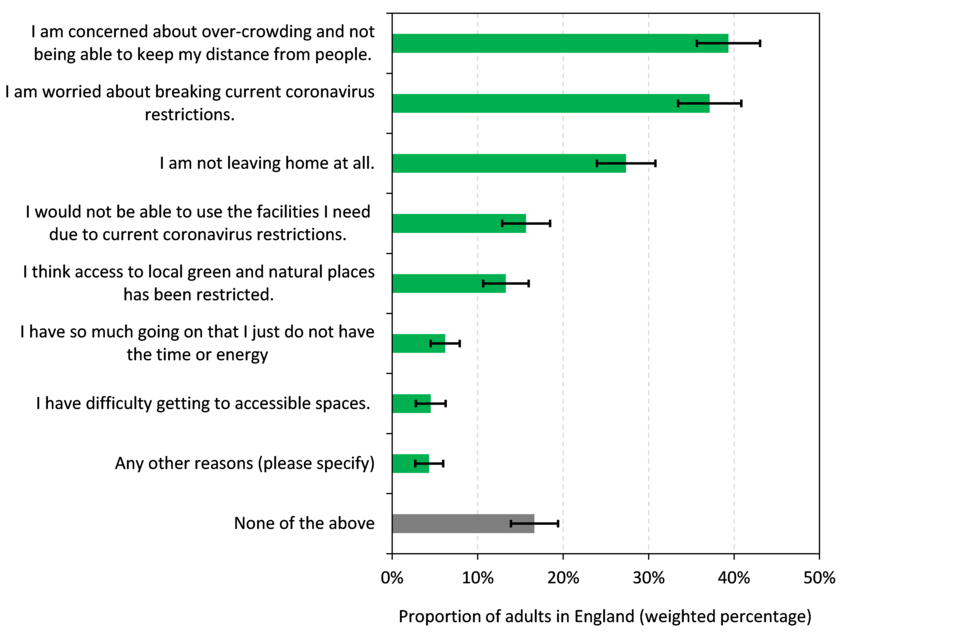
Figure notes
Source: Question 29b in the People and Nature Survey (May 2020): Thinking about the time since coronavirus restrictions were introduced, have any of the following reasons prevented you spending time outside?
(1) May refers to the period May 1st to 31st (inclusive).
(2) The sample for this question was 754 respondents who reported not spending any time in green and natural places in the last 14 days.
(3) Error bars represent the 95% confidence interval of the mean (see Glossary).
(4) Respondents can select more than one option and so percentages will not add up to 100%.
The People and Nature Survey shows that for those who did not visit green and natural places in the last 14 days concern about coronavirus was a main reason. This is consistent with findings from a survey by the Office for National Statistics (ONS); they found that across Great Britain, a quarter (26%) of all people felt unsafe or very unsafe when outside their home due to the coronavirus outbreak during the last week of May and 26% felt unsafe taking part in outdoor leisure activities[footnote 4].
9. The role of green and natural spaces for health and wellbeing
Respondents were asked: How much do you agree or disagree with the following statements:
-
In general, green and natural spaces should be good places for mental health and wellbeing.
-
In general, green and natural spaces should be places that encourage physical health and exercise.
The vast majority of adults (89%) agreed or strongly agreed that green and natural spaces should be good places for mental health and wellbeing. Notably, half of adults (53%) strongly agreed. Only 2% disagreed or strongly disagreed with the statement. These findings are consistent with results for April.
Eighty three percent of adults agreed that green and natural spaces should be places that encourage physical health and exercise (with 37% strongly agreeing). Only 3% disagreed or strongly disagreed with the statement. These findings are consistent with results for April.
When asked to reflect on the period since the coronavirus restrictions began, 41% stated that visiting local greenspaces was more important than ever to their wellbeing and 30% reported visiting local green and natural spaces more.
An RSPB survey[footnote 3] of adults in England during 14-15 May 2020, found that 87% of respondents agreed that living close(r) to spaces that are rich in wildlife and nature is/would be an advantage during the Coronavirus (COVID-19) outbreak and 76% agreed that nature has been an important source of comfort/relief for them.
10. Feelings of nature connection
Nature connectedness describes a person’s relationship with the natural world and how it makes them feel (see Glossary and this summary report on development of nature connectedness indicators used in the People and Nature Survey).
In May, 85% adults agreed that they felt very happy when in nature (with 46% strongly or completely agreeing). Only 3% disagreed with the statement (Figure 8). These findings are consistent with results for April.These figures correspond closely to those found by the RSPB in a recent survey[footnote 3] where 81% of respondents agreed they had felt happier whilst/after spending time visiting nature.
Figure 8: Proportion of adults in England agreeing with the following statements: “Being in nature makes me very happy” and “I feel part of nature” (May 2020). Over 85% and 60% of respondents either agreed, strongly agreed or completely agreed with these statements respectively.
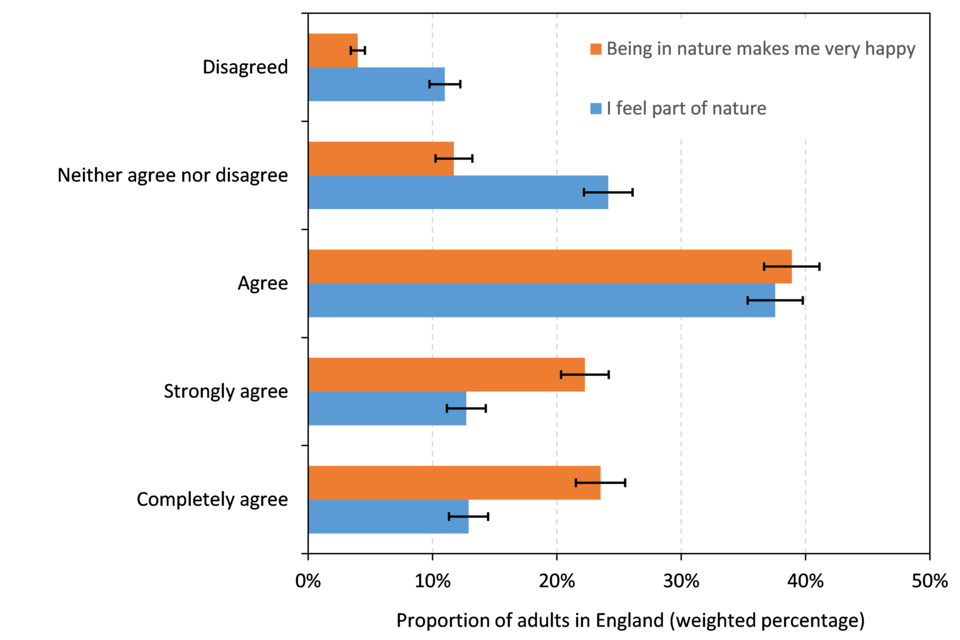
Figure notes
Source: Question 49a/b in the People and Nature Survey (May 2020): How much do you agree or disagree with the following?
(1) Disagreed category includes ‘completely disagree’, ‘strongly disagree’ and ‘disagree’.
(2) May refers to the period May 1st to 31st (inclusive).
(3) The sample for this question was 2,083 respondents.
(4) Error bars represent the 95% confidence interval of the mean (see Glossary).
In May, 74% of adults agreed that they are ‘taking more time to notice and engage with every day nature (e.g. listening to birdsong, noticing butterflies)’. Only 8% disagreed with the statement (Figure 9).
Figure 9: Proportion of adults in England agreeing with the following statement: “I am taking more time to notice and engage with everyday nature (e.g. listening to birdsong, noticing butterflies)” (May 2020). Three quarters of respondents either agreed, strongly agreed or completely agreed with this statement.
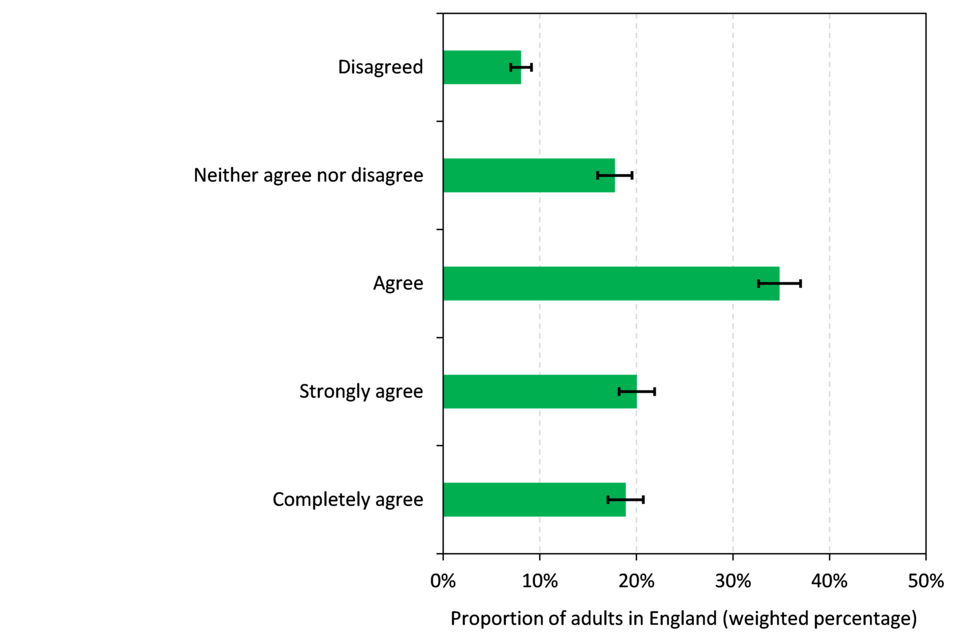
Figure notes
Source: Question 49PLUSc in the People and Nature Survey (May 2020): How much do you agree or disagree with the following?
(1) Disagreed category includes ‘completely disagree’, ‘strongly disagree’ and ‘disagree’.
(2) May refers to the period May 1st to 31st (inclusive).
(3) The sample for this question was 2,083 respondents.
(4) Error bars represent the 95% confidence interval of the mean (see Glossary).
In May, 41% adults agreed that ‘nature/wildlife is more important than ever to my wellbeing’ since the coronavirus restrictions began (Figure 10). Five per cent reported participating in organised wildlife activities such as Big Garden Birdwatch. A minority (4%) reported noticing ‘less wildlife than I do usually’ and 6% reported finding it difficult to observe or interact with nature.
Figure 10: Respondents’ engagement with nature since coronavirus restrictions began (as proportion of adults in England) (May 2020). Forty four percent of respondents said they have spent less quality time outside with family and friends. Forty one percent stated that both visiting local greenspaces and nature/wildlife are more important than ever to their wellbeing.
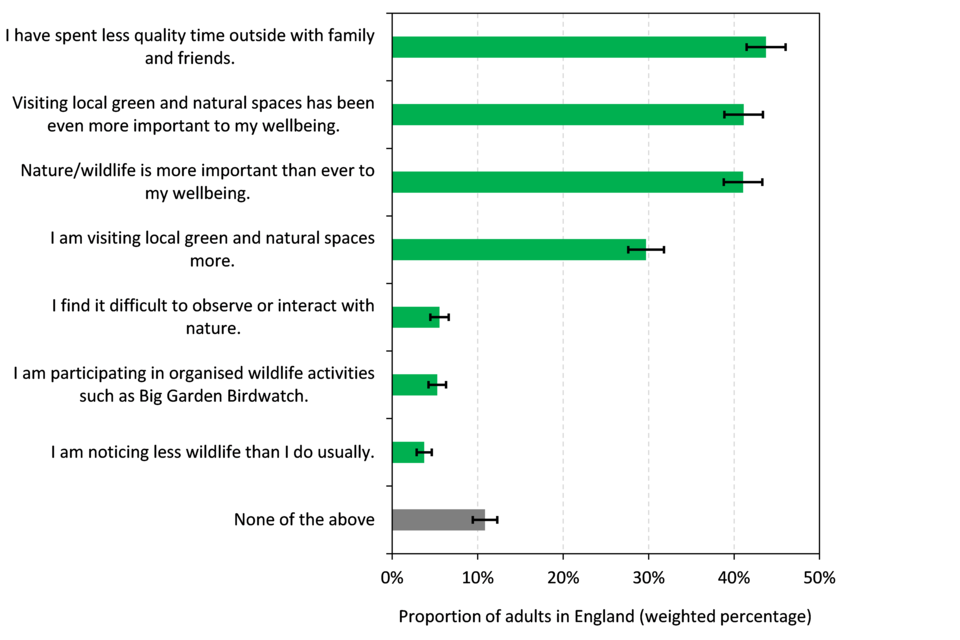
Figure notes
Source: Question QCV1 in the People and Nature Survey (May 2020): Thinking about life since the coronavirus restrictions began, have you noticed or done any of the following?
(1) May refers to the period May 1st to 31st (inclusive).
(2) The sample for this question was 2,083 respondents.
(3) Error bars represent the 95% confidence interval of the mean (see Glossary).
(4) Respondents can select more than one option and so percentages will not add up to 100%.
11. Importance of having access to a garden or allotment
Of those respondents who said that they had access to a private or shared garden, outdoor space or allotment, 87% agreed that having this access is important to them personally (with 63% agreeing it is very important). Only 4% stated it was not important to have access. These findings are consistent with results for April.
One in eight households (12%) in Great Britain had no access to a private or shared garden during the coronavirus (COVID-19) restrictions and there is inequality in access to garden spaces associated with ethnicity, age, socio-economic background and region[footnote 6]. A RSPB survey in May[footnote 3] found that people in the UK with an annual household income under £10,000 are almost four times more likely to have no outdoor space compared to people with a household income of £60,000 or more.
12. Behaviour changes during the Coronavirus pandemic
Respondents were asked whether, since the coronavirus restrictions began, they have increased the amount of time spent on any of the following: connecting with family or friends outdoors; spending time outside; exercising outdoors; working from home; volunteering; noticing nature / wildlife (Figure 11).
Thirty six percent of respondents reported that they were spending more time outside, 33% are spending more time noticing nature / wildlife and 29% reported spending more time exercising outdoors.
Figure 11: Change in behaviours since the coronavirus restrictions began (May 2020): A third of respondents stated they had spent more time outside and noticing nature / wildlife, with 29% saying they had been exercising outdoors more.
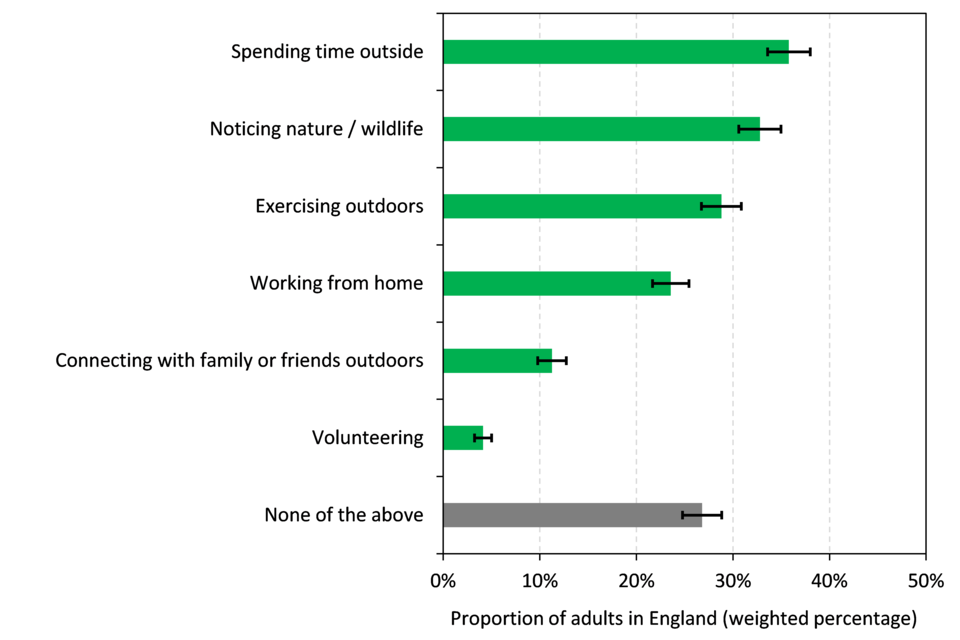
Figure notes
Source: Question QCV2a in the People and Nature Survey (May 2020): Since the coronavirus restrictions began, have you increased the amount of time spent on any of the following?
(1) May refers to the period May 1st to 31st (inclusive).
(2) The sample for this question was 2,083 respondents.
(3) Error bars represent the 95% confidence interval of the mean (see Glossary).
(4) Respondents can select more than one option and so percentages will not add up to 100%.
Respondents were also asked whether, since coronavirus restrictions began, they had reduced: the amount they drive or travel by car; the amount of food their household throws away; the amount of meat that they eat (Figure 12).
A large majority of people reported that they had reduced the amount they drive or travel by car (72%), with two fifths (40%) of people also saying that they had reduced the amount of food their household throws away.
Figure 12: Environmental behaviour changes since the coronavirus restrictions began (May 2020): Proportion of adults in England who reported reductions in activities stated. Almost three quarters said they had reduced the amount they drove or travelled by car, with 40% stating they threw away less food.

Figure notes
Source: Question QCV3a in the People and Nature Survey (May 2020): since the coronavirus restrictions began, have you reduced…?
(1) May refers to the period May 1st to 31st (inclusive).
(2) The sample for this question was 2,083 respondents.
(3) Error bars represent the 95% confidence interval of the mean (see Glossary).
(4) Respondents can select more than one option and so percentages will not add up to 100%.
Survey respondents were also asked whether they would like to continue these changes after the coronavirus restrictions end and this will be reported in future releases. An Office for National Statistics (ONS) survey in May 2020[footnote 7] found that 92% agreed ‘stay at home measures have positively affected the environment’ and 91% agreed ‘where there have been positive changes to the environment because of the coronavirus pandemic, society should try to keep doing them’.
13. Childrens time in nature
Respondents were asked whether they have children under the age of 16 living in their household. If yes, follow-up questions recorded number of children, their age and gender. Note that the sample size for this question was small (264 adult respondents) and so results should be treated with caution.
Adult respondents reported that, on average over the past 12 months, 82% of children spent time in green and natural spaces at least once a week. Ten percent of children were reported as visiting green and natural space less than once a month or never. These findings are consistent with results for April.
Adults were asked about their children’s experiences with nature and the outdoors since coronavirus restrictions started (Figure 13). Forty percent reported that their child seems happier when they have spent time outside, with 38% wishing their child could spend more time outside to support their physical health.
Almost a third of respondents (32%) were worried that their child was spending too much time indoors and 29% wished their child could spend more time outside in nature to support their mental health.
Almost a fifth (19%) agreed that ‘learning outside or about nature is especially important’.
Figure 13: Children’s engagement with nature and time spent outdoors since coronavirus restrictions started (proportion of adults in England reporting on a child in their household) (May 2020). Forty percent of adults thought their child seemed happier when they had spent time outdoors, and a similar percentage (38%) wished their child could spend more time outside to support their physical health.

Figure notes
Source: Question 39c in the People and Nature Survey (May 2020): thinking about the time since coronavirus restrictions started…?
(1) May refers to the period May 1st to 31st (inclusive).
(2) The sample for this question was 264 respondents with a child in their household. Note that the small sample size means results should be treated with caution.
(3) Error bars represent the 95% confidence interval of the mean (see Glossary).
(4) Respondents can select more than one option and so percentages will not add up to 100%.
14. Methodological notes
The People and Nature Survey for England gathers evidence and trend data through an online survey relating to people’s enjoyment, access, understanding of and attitudes to the natural environment, and its contributions to wellbeing.
People and Nature is an online panel survey (self-completion questionnaire), sampling up to 25,000 adults in England on a continuous basis over 2020/2021. The survey launched in April 2020 and builds on the Monitor of Engagement with the Natural Environment (MENE) survey that ran from 2009 to 2019.
The People and Nature Survey consists of different modules. All modules are asked throughout the entire year, but certain modules (those that do not require an overall sample size of 25,000) are only asked to a randomly selected sub-sample of individuals. This means that some questions will have responses from everyone asked and some will have a smaller sample size.
The People and Nature Survey will release a full dataset on a quarterly basis, with the first data release scheduled for September 2020.
Data from the People and Nature Survey will initially be released as ‘Experimental Statistics’, a form of Official Statistics that are in the testing phase. In response to the coronavirus (COVID-19) pandemic, we have provided an early release of some indicative metrics using data from a subset of the survey questions. This early release will enable us, in a timely manner, to better understand the impacts and implications of COVID-19 on people’s engagement with nature, health and wellbeing, and will inform the Government’s and others’ plans for recovery.
14.1 Sampling
A sample of households was selected from the England subset of Kantar’s Lightspeed Panel. Samples are representative of the target population (adults aged 16 or older living in England) and quotas for age, gender, region, education and ethnicity are in place to ensure key population groups are adequately represented.
For this second release 2,083 individuals were sampled for the survey conducted from 1st May to 31st May 2020. Not all questions were asked of all 2,083 individuals and sample sizes are indicated in each report section.
14.2 Weighting
These early release indicators are interim and they may be subject to change once the final bespoke weighting solutions for the People and Nature Survey have been developed[footnote 8].
The weighting used for the monthly interim indicators will be representative of the English adult population, according to the latest population estimate data available from the Office for National Statistics and based on the weighting developed for the MENE survey data[footnote 9]. This approach is appropriate given the large similarities between MENE and the People and Nature Survey, and the significant amount of MENE data which supports the selection of key variables used to develop the MENE weights. These have been applied at aggregate level for each monthly People and Nature interim indicator.
Weights have been checked to ensure that they scale to the sample size for each indicator. For indicators where respondents are only able to select one response option, proportions have been checked to ensure they add up to 100%. Associated 95% confidence intervals are also reported.
More information about the People and Nature Survey and the latest questionnaire are available.
15. Strengths and limitations
15.1 Experimental statistics collected via an online panel
The People and Nature Survey is conducted by Kantar using its online Lightspeed panel. The online panel brings benefits in terms of speed, ability to interview during lockdown and reducing social desirability bias. However, it is important to flag limitations:
- Since panels are opt-in there is the risk that panellists are not representative of the general population.
- Online panel surveys exclude the off-line population.
To minimise the risk of bias, Lightspeed uses a variety of recruitment methods. This includes opt-in email, e-newsletter campaigns, and social media.
Sample composition analysis during development of these statistics compared online panel methods and MENE. It showed that the online samples tend to be more representative than MENE in terms of age and working status. However, online samples tend not to represent the very oldest in the population well (as they are the least likely to have internet access). Both the online panel and MENE tend to achieve samples that are broadly representative of the population by region. Online samples tend to under-represent people from ethnic minority backgrounds, which is why an additional quota criteria on ethnicity was set for the People and Nature Survey. The survey was developed specifically to ensure it worked well on mobile devices. Quota objectives to achieve a nationally representative sample in terms of age, gender, region, ethnicity, and education level were achieved for the May sample (at least 95% of the target). Work is continuing to understand strengths and limitations of the panel method during the experimental phase and further information will be published in due course.
15.2 Comparing the monthly interim indicators with other data
Where appropriate, these interim monthly indicators have been compared against other data sources and we report where similar or contrasting trends have been identified.
Although similar types of data are reported, direct comparisons of the People and Nature Survey and MENE findings should not be made. The People and Nature Survey has similar aims and many similar questions to MENE and, like the external survey data included in these monthly reports, it provides useful context. However, it is important to note significant differences in methods could have an impact on results. The People and Nature Survey uses an online panel approach whereas MENE used face-to-face interviews; there are differences in how respondents answer questions between these two different survey methods. Furthermore, for many questions, there have been other changes including question recall period and question length, plus new questions have been added to the People and Nature Survey.
Natural England are exploring an approach to calibrate a small number of key metrics from the People and Nature Survey and MENE. This approach aims to harmonise these metrics before and after the change in survey approach.
We have decided the best approach for calibration is ‘backward’ harmonisation. This will mean some historical MENE metrics will change (i.e. a new calibration factor will be applied to some metrics calculated from historical MENE data to allow for a degree of continuity between MENE and the new People and Nature Survey).
To harmonise any metrics between the People and Nature Survey and MENE, a parallel run will take place where online and face-to-face interview approaches are conducted at the same time. Due to current COVID-19 restrictions, the feasibility of harmonising certain metrics between the People and Nature Survey and MENE will be unknown until face-to-face interviews can be safely conducted over a sufficient amount of time (ca. 1 year).
15.3 Socio-demographic characteristics
Results from MENE indicated that there was inequality of environmental engagement between population sub-groups defined by a number of demographic characteristics (including: age, ethnicity, and socio-economic background, region, urban-rural and health).
The People and Nature survey launched in April 2020 and has been designed to report findings by socio-demographic characteristics. This is planned for the first quarterly release in September 2020. Reporting on a quarterly basis (rather than monthly) ensures larger sample sizes are reported against each question, thereby reducing standard errors.
16. Glossary
95% confidence interval is a range of values around a calculated statistic (e.g. the mean) that you are 95% certain contains the true value of that statistic. For example, where there is a mean value of 49 with a 95% confidence interval of 2, we would be 95% certain that the true mean of the population was in the range of 47-51 (i.e. 49 -2 and 49 + 2).
Green and natural spaces are defined in this survey as green spaces in towns and cities (e.g. parks, canals); the countryside (e.g. farmland, woodland, hills and rivers); the coast (e.g. beaches, cliffs) and activities in the open sea; visits of any duration (including short trips to the park, dog walking etc). They do not include: gardens; outside spaces visited as part of someone’s employment; spaces outside the UK.
Nature connectedness: a measurable psychological construct that describes a person’s relationship with the natural world. It includes aspects related to a person’s affective (emotional) and cognitive relationship to nature and their sense of place in nature. The 6 Nature Connection Index scale items are:
- I always find beauty in nature
- I always treat nature with respect
- Being in nature makes me very happy
- Spending time in nature is very important to me
- I find being in nature really amazing
- I feel part of nature
Weighting: this process corrects for both proportion and scale – i.e. it adjusts the results to reflect both the underlying characteristics and the size of the target population. Thereby ensuring that the results are representative of the target population.
17. Contact
Natural England welcomes feedback on these monthly indicators, questions and suggestions for analysis for future releases. Please contact the team by email: people_and_nature@naturalengland.org.uk
Additionally, to receive updates on the survey, including data releases and publications, sign-up via the People and Nature User Hub.
The Senior Responsible Officer for this publication is Dr Rose O’Neill.
18. Pre-release access
Pre-release access was not sought for this release.
19. Related links
Coronavirus – guidance on accessing green spaces safely: Latest government guidance on using green spaces and protecting yourself and others.
Natural England operational update: Coronovirus information on how Natural England is facing the challenges posed by Coronavirus.
People and Nature questionnaire: Includes link to People and Nature Survey questions.
People and Nature Survey information: Further information on the People and Nature Survey for England.
Monitor of Engagement with the Natural Environment: Further information on the Monitor of Engagement with the Natural Environment (MENE) Survey (predecessor to the People and Nature Survey).
Office for National Statistics Coronavirus and the social impacts on Great Britain Statistical bulletins Series: Office for National Statistics reports on the social impacts of coronavirus in Great Britain.
Office for National Statistics analysis of access to greenspace during coronavirus: Office for National Statistics report on access to greenspace, including gardens, during coronavirus (uses MENE data).
RSPB “Recovering Together” Report June 2020: A report of public opinion on the role and importance of nature during and in our recovery from the Coronavirus crisis in England.
A summary report on nature connectedness among adults and children in England: Includes analyses of relationships with wellbeing and pro-environmental behaviours (uses MENE data).
Coronavirus (COVID-19): safer public places - urban centres and green spaces: Guidance for the owners and operators of urban centres and green spaces to help social distancing.
The Countryside Code: Statutory guidance on respecting, protecting and enjoying the outdoors.
-
Google LLC “Google COVID-19 Community Mobility Reports”. https://www.google.com/covid19/mobility/ Accessed: 15/06/20. ↩
-
The average percentage change for park mobility data for May is + 33.16 with a 7.20 standard error and a 95 percent confidence interval (18.46 - 47.86). All values rounded to 2 decimal places. ↩
-
RSPB “Recovering Together” June 2020 https://www.rspb.org.uk/globalassets/downloads/recovering-together-report/recovering-together-report_nature-and-green-recovery_rspbyougov_june-2020.pdf Accessed: 30/06/20. Fieldwork was undertaken on 14-15 May 2020. Total sample size for the UK was 2,155, and the net sample size for England was 1,812 adults. The survey was carried out online. The figures were weighted and are representative of all UK adults (aged 18+). ↩ ↩2 ↩3 ↩4
-
Office for National Statistics “Coronavirus and the Social Impacts on Great Britain” 5th June 2020 https://www.ons.gov.uk/peoplepopulationandcommunity/healthandsocialcare/healthandwellbeing/bulletins/coronavirusandthesocialimpactsongreatbritain/5june2020 Accessed: 30/06/20 ↩
-
Office for National Statistics “One in eight British households has no garden” 14 May 2020 https://www.ons.gov.uk/economy/environmentalaccounts/articles/oneineightbritishhouseholdshasnogarden/2020-05-14 Accessed: 30/06/20 ↩
-
Office for National Statistics “Coronavirus and the Social Impacts on Great Britain” 22 May 2020 https://www.ons.gov.uk/peoplepopulationandcommunity/healthandsocialcare/healthandwellbeing/bulletins/coronavirusandthesocialimpactsongreatbritain/22may2020 Accessed: 30/06/20. 1,000 and 950 people surveyed respectively in Great Britain during 14-17 May. ↩
-
Developing bespoke weights for the full People and Nature survey dataset will require at least 3-6 months of data to understand relationships between variables and demographics. Therefore the final weighting scheme will not be finalised until at least the end of 2020. ↩
-
https://assets.publishing.service.gov.uk/government/uploads/system/uploads/attachment_data/file/875153/MENE_Technical_Report_Years_1_to_10v2.pdf ↩

